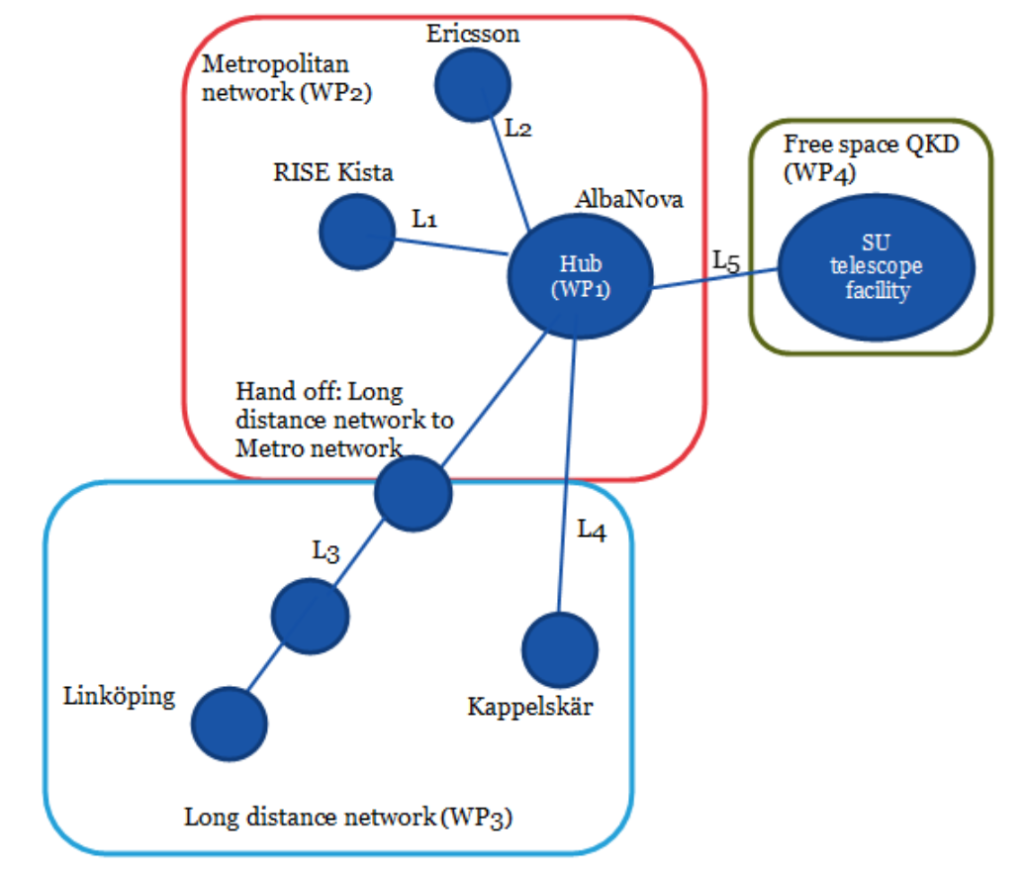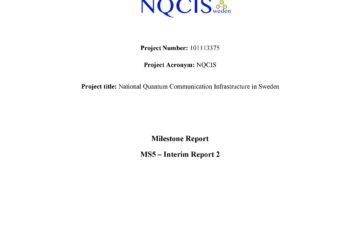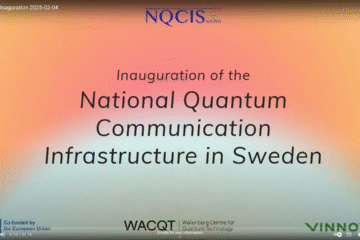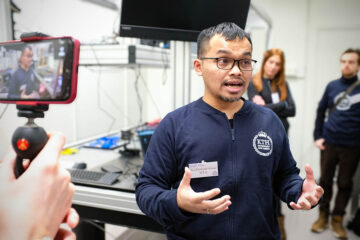As the first year of the NQCIS project, National Quantum Communication Infrastructure in Sweden comes to an end, we would like to summarise the development of the project, but first to put our efforts into perspective.
The first quantum revolution can be attributed to the development of theory and experiments postulated by Einstein, Heisenberg, and Schrödinger, which typically relate to formulations of quantum principles. However, now, thanks to revolutionary work from luminaries like Aspect, Bennett, Brassard, Ekert, Shor, Feynman, and Haroche (some of whom are Nobel laureates) starting in the second half of the 20th century, we are currently in the second quantum revolution, where we are able to translate those quantum principles into experimental work like the active manipulation of single quantum particles or the study of interactions between multiple particles. These advancements have already resulted in or will soon result in huge leaps in computing power, increased understanding of complex physical systems, measurement precision beyond the classical limits, and secure communication, to name just a few. Several countries (Sweden included) are, therefore, investing in quantum technologies. An added benefit is that quantum technologies can help strengthen cyber security in communication, which has become a critical issue and will be even more so in the future, with quantum computers in the near horizon, which hold promise to crack many of the cryptographic algorithms in use today. Quantum communication offers several advantages over classical communication: unconditional security against any type of eavesdropping attack but also the possibility to connect quantum computers and to achieve low-power communication many orders of magnitude lower than in existing networks. This will strengthen Swedish and European society by making crucial systems safe from hacking by hostile organisations.
The laws of quantum mechanics allow to encrypt intrinsically secure information based on the physical principle, which states that measurement causes a perturbation. This enables the detection of eavesdroppers, and the intercepted information can be immediately discarded. Quantum key distribution (QKD) works on this principle by sending quantum states of light or photons via optical fibres or in free space, which can be deployed in existing communication infrastructures.
The European Commission has launched a large and concerted action with the 27 EU member states to integrate quantum-based systems into existing communication infrastructures and provide an additional security layer based on quantum physics to safeguard sensitive data and critical infrastructures in Europe. The initiative to build a quantum-secured communication infrastructure spanning the whole EU was launched in 2019 with the EuroQCI Declaration. The EuroQCI’s first implementation phase started in January 2023 with the support of the Commission’s Digital Europe Programme, to national projects allowing Member States to design and build the national quantum communication networks that will be the backbone of the terrestrial segment, testing different technologies and protocols and adapting them to the specific needs of each country. The national QCI projects have an implementation period of 2.5 years and a budget of up to 10 million euros per country, where 50% of it is financed by the EU and the other 50% by national actors. In the case of Sweden, the national co-funding to NQCIS) the is provided by Vinnova, Sweden’s innovation agency, the Quantum Communication pillar in WACQT, the Wallenberg Centre for Quantum Technology and all our partner institutions.
Our goal is to develop a practical, open testbed which is defined by the use cases specific to the needs of Sweden, where it will be possible to deploy QKD systems and perform tests of interoperability between fibre providers, technologies, vendors, and test the maturity levels of the various commercially available products. The hub will be quintessential in understanding the ease of integration of commercial equipment into the existing fibre networks for different network topologies and contribute towards EU-level benchmarking and standardisation of interfaces and protocols.
As a part of our work, we are building a central facility at the AlbaNova University Centre in Stockholm, from which we have deployed fibre links firstly towards the already planned user cases, encompassing KTH-RISE high-speed transmission labs in Kista (L1) and the Ericsson Quantum labs (L2) in Kista (see figure 1). By the end of the project, NQCIS will run a central facility open to all trained users that may apply for facility time to develop further use cases. The facility will deploy commercially available QKD systems for secret key delivery with both Discrete Variable (DV, where the encoding for the QKD protocol is done using discrete parameters of the photons such as polarisation or arrival time) and Continuous Variable (CV) modalities where the encoding is done in the quadratures of the coherent light that is used, i.e. the amplitude and phase. From 2024 onwards, the Stockholm hub will also host open days, training and information activities where key stakeholders and the general public will be invited to the hub to participate in the learning and design of future use cases.
Our second endeavour is to perform tests of interoperability and switching experiments between the DV and CV systems alongside implementing two additional links (L3, L4), which will connect the long-distance networks to the metropolitan network and the central hub. We are characterising L1 and L2, which we currently have operational for parameters such as optical loss, polarisation drift and so on. L1 and L2 will implement CV technologies, while L3 and L4 will implement DV technologies. Additionally, we will also test a secure video conference on one of the metropolitan use case links, and this can potentially be one of the services that the facility can provide to interested users.
Secure transmissions over long (several hundreds of km) distances are crucial for Sweden due to the very sparse distribution of the population in the Country. Accordingly, NQCIS is devoting substantial efforts to implementing ad-hoc solutions for this purpose, using multiple commercial QKD devices at trusted nodes and exploring innovative schemes such as twin-field (TF) QKD. This work package also develops the next preparatory steps for future cross-border links to neighbouring national QCI networks in Finland, Denmark, Estonia and Latvia. The work package is currently procuring the necessary fibre infrastructure and establishing the requirements for QKD devices before going into the procurement phase. We are currently also investigating several possible TF-QKD implementation scenarios for Sweden.
Finally, we are also conducting preparatory work to connect the terrestrial and space segments in Stockholm by developing an interface connecting the 1m rooftop SU telescope, which is currently in use for Astronomy and outreach, to the central NQCIS hub facility in Stockholm. In particular, in view of future EuroQCI developments for European and intercontinental secure quantum communications, we are developing designs to upgrade the astronomy facility to enable an optical ground station which can track low earth orbit satellites. As a receiver station, it will also need to be efficiently coupled to single photon detectors. An additional avenue to be investigated in parallel through this work package envisages the procurement of a mobile telescope for additional use cases and future on-field deployment and testing at different locations in Sweden.

Figure 1 A pictorial description of the planned work packages and network for NQCIS.


